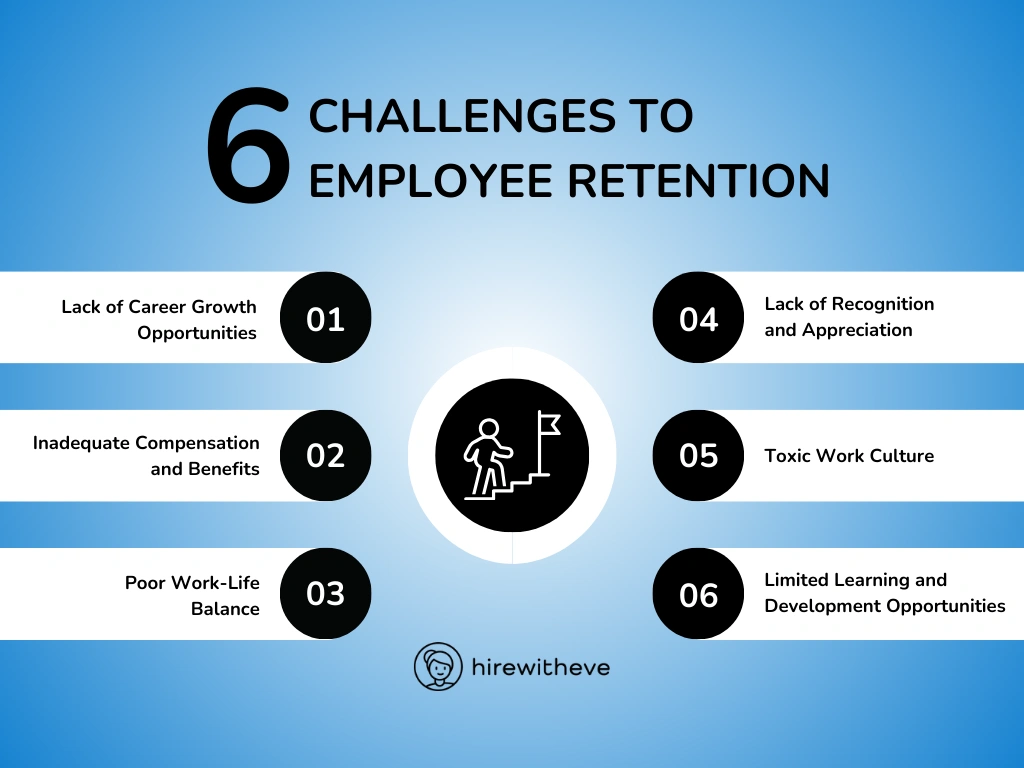6 Employee Retention Challenges and How to Tackle Them

Employee retention is one of the most pressing challenges businesses face today.
In a competitive job market, keeping top talent engaged and committed has become increasingly difficult. High turnover not only impacts productivity and morale but also leads to significant recruitment and training costs. To stay ahead, companies need to understand the underlying factors that cause employees to leave and develop strategies to keep them on board.
In this blog, we’ll explore six major employee retention challenges and offer practical solutions to tackle them head-on, ensuring your team remains loyal and motivated.
Why Is Employee Retention Important?
Employee retention is crucial for several reasons that directly impact a company’s productivity, culture, and bottom line:
Cost Efficiency
Hiring and onboarding new employees can be expensive and time-consuming. It involves costs related to recruitment, training, and the loss of productivity during the transition. Retaining employees saves on these costs and ensures continuity in operations.
Maintains Productivity
Experienced employees understand the workflow, company culture, and their specific roles better than new hires. When retention rates are high, businesses benefit from sustained productivity and the expertise that long-term employees bring.
Boosts Employee Morale
High employee turnover can lower morale among remaining team members. They may become disengaged or stressed if they constantly see colleagues leaving. Retaining employees creates a stable and positive work environment, boosting overall morale and engagement.
Preserves Institutional Knowledge
Employees who have been with the company for a long time hold valuable institutional knowledge. Losing them can mean a loss of critical information and experience that is hard to replace quickly.
Strengthens Employer Branding
High retention rates reflect positively on an organization’s reputation. Companies known for retaining employees often attract top talent, as it signals a supportive and rewarding work environment.
6 Challenges to Employee Retention
Here are six major challenges to employee retention and why they are critical for businesses to address:

Lack of Career Growth Opportunities
Challenge: Employees often leave when they feel there’s no clear path to advancement. Without opportunities to grow, develop new skills, or move into leadership roles, they may seek opportunities elsewhere.
Impact: This can lead to frustration and disengagement, ultimately causing top performers to leave the organization.
Inadequate Compensation and Benefits
Challenge: Competitive pay and benefits are essential for employee retention. When compensation doesn’t match industry standards or employee expectations, dissatisfaction grows, pushing employees to look for better-paying roles.
Impact: Companies that don’t offer competitive compensation may experience high turnover, especially among skilled and high-demand professionals.
Poor Work-Life Balance
Challenge: In today’s fast-paced work environments, employees value flexibility and a healthy work-life balance. Overwork, stress, and rigid schedules can cause burnout, leading employees to seek more balanced opportunities.
Impact: If employees feel overwhelmed by excessive workloads or lack flexibility, retention becomes difficult, particularly in remote or hybrid work settings.
Lack of Recognition and Appreciation
Challenge: Employees need to feel valued for their contributions. When recognition is lacking, employees may feel unappreciated, which affects their engagement and loyalty to the company.
Impact: A lack of regular acknowledgment or reward for good work can lead to decreased motivation, lowering retention.
Toxic Work Culture
Challenge: A negative or toxic work environment can drive employees away. Factors like poor management, office politics, lack of collaboration, and insufficient support can lead to a hostile or unproductive culture.
Impact: Employees who feel disrespected or unsupported are more likely to leave in search of a healthier workplace.
Limited Learning and Development Opportunities
Challenge: Employees, especially those looking to grow their careers, value continuous learning and development. When companies don’t invest in upskilling or personal development, employees may feel stuck and leave to advance elsewhere.
Impact: Organizations that fail to offer training or skill development may struggle to retain ambitious, growth-oriented employees.
How to Tackle These Employee Retention Challenges?
To tackle these employee retention challenges, businesses must implement targeted strategies that address the core concerns of their workforce.
Here’s how to address each of the six challenges effectively:
Provide Career Growth Opportunities
Solution: Create clear career development paths and provide regular feedback on performance. Implement mentorship programs and internal promotions to show employees that there’s room for advancement within the company.
Benefit: Employees feel invested in and are more likely to stay when they can visualize their future in the organization.
Offer Competitive Compensation and Benefits
Solution: Regularly review and adjust salaries and benefits to align with market standards. Offer flexible benefits such as health coverage, retirement plans, bonuses, and wellness programs.
Benefit: When employees feel they are compensated fairly, they are more satisfied and less likely to seek other opportunities.
Promote Work-Life Balance
Solution: Implement flexible working arrangements, such as remote work options or flexible hours. Encourage employees to take time off and avoid burnout by promoting a healthy work-life balance.
Benefit: A balanced work-life environment reduces stress and burnout, improving retention by helping employees feel supported both professionally and personally.
Recognize and Reward Achievements
Solution: Establish a culture of recognition through regular praise, rewards, and incentives. Recognize achievements in team meetings, offer bonuses, or provide additional paid time off.
Benefit: Employees who feel appreciated are more motivated, engaged, and likely to stay loyal to the organization.
Foster a Positive Work Culture
Solution: Build an inclusive and supportive workplace by encouraging open communication, collaboration, and transparency. Offer conflict resolution resources and invest in leadership training to cultivate a positive environment.
Benefit: A strong, positive culture improves employee satisfaction and fosters long-term loyalty, reducing turnover.
Invest in Learning and Development
Solution: Offer continuous learning opportunities through workshops, online courses, and professional development programs. Encourage cross-training and provide financial support for certifications and higher education.
Benefit: Employees are more likely to stay if they feel they are constantly learning and developing their skills, making them feel valued and engaged.
By implementing these solutions, businesses can not only tackle the challenges of employee retention but also foster a loyal and motivated workforce.
At HirewithEve.ai, we understand the importance of retaining top talent. Our platform ensures that you hire candidates who not only fit the role but align with your company culture, reducing the likelihood of turnover and helping you build a strong, engaged team from the start.
Conclusion
Tackling the six major employee retention challenges — lack of career growth, inadequate compensation, poor work-life balance, lack of recognition, toxic work culture, and limited learning opportunities — is crucial for building a resilient, engaged workforce. By addressing these challenges with thoughtful strategies, businesses can improve employee satisfaction, reduce turnover, and boost long-term success.
HirewithEve.ai help you to get ahead of these challenges from the very start by ensuring you hire candidates who are not only skilled but also aligned with your company’s culture and long-term vision. With the right fit, retention becomes easier, and your organization benefits from a stable, motivated team.
